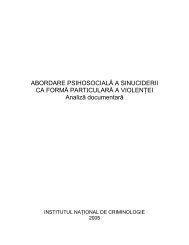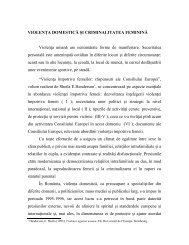REVISTA DE CRIMINOLOGIE, CRIMINALISTICĂ ŞI PENOLOGIE Nr ...
REVISTA DE CRIMINOLOGIE, CRIMINALISTICĂ ŞI PENOLOGIE Nr ...
REVISTA DE CRIMINOLOGIE, CRIMINALISTICĂ ŞI PENOLOGIE Nr ...
Create successful ePaper yourself
Turn your PDF publications into a flip-book with our unique Google optimized e-Paper software.
Conducătorii auto, şi în special tinerii, sunt informaţi despre efectele nocive asupra organismului şi riscului<br />
la care se supun atât prin consumul de alcool şi droguri, cât şi de asocierea fatală dintre acestea, considerate a fi<br />
cauze importante, dar mai puţin cunoscute, de mortalitate şi de producere a accidentelor rutiere.<br />
Iniţiat anul trecut de Inspectoratul General al Poliţiei Române, în colaborare cu Ministerul Transporturilor,<br />
prin Compania Naţională de Autostrăzi şi Drumuri Naţionale, Autoritatea Rutieră şi Registrul Auto Român,<br />
Ministerul Educaţiei, Cercetării şi Tineretului, administraţiile publice locale şi alte organisme implicate în<br />
transporturi rutiere, programul partenerial „STOP Accidentelor! - Viaţa are Prioritate!” are drept scop declarat<br />
reducerea numărului accidentelor de circulaţie mortale cu 5%, prin impunerea legii, reducerea vulnerabilităţii<br />
categoriilor defavorizate de participanţi la trafic, educaţia populaţiei, sensibilizarea opiniei publice.<br />
Poate ca o consecinţă (sau o componentă!) a acestei campanii, în ultima vreme ştirile sunt bombardate cu<br />
imagini de la accidente rutiere. Rolul mass-mediei devine foarte important! Imaginile de la locurile accidentelor însă<br />
parcă nu comunică suficient, sunt impersonale. Un morman de fiare contorsionate nu sperie pe nimeni. Un<br />
cadavru...care ai putea fi tu, TE SPERIE. Un copil în comă...care ar putea fi al tău, TE SPERIE...<br />
De aici încolo, TU trebuie să-ţi doreşti să asiguri tuturor: copii, tineri, prieteni, colegi... un TRAFIC<br />
RUTIER MAI SIGUR!<br />
Bibliografie:<br />
1. D. Stockley, Drug Warning, an illustrated guide for parents, teachers and employers, Optima Books,<br />
London, 1992<br />
2. U.E. Program finanţat prin PHARE, M.I., I.G.P., D.G.C.C.O.A. - Brigada Antidrog, Îndreptar privind<br />
alcoolul, tutunul şi alte droguri, Editura M.I., 2002<br />
3. Dr. Jose Antonio Garcia Rodriguez, Copilul meu, drogurile şi eu, Editura M.I., Bucureşti, 2002<br />
4. Ioan Roibu, Alexandru Mircea, Flagelul drogurilor la nivel mondial şi naţional, Editura Mirton<br />
Timişoara, 1997<br />
5. Stoica Mihai Gheorghe, Ioniţă Tudor, Drogul în drept - Doctrină şi legislaţie internă şi internaţională,<br />
Editura Mirador, 1997<br />
CERCETAREA <strong>CRIMINALISTICĂ</strong><br />
A MICROURMELOR <strong>DE</strong> FIBRE TEXTILE<br />
<strong>DE</strong>SCOPERITE LA FAŢA LOCULUI<br />
ÎN CAZUL ACCI<strong>DE</strong>NTELOR <strong>DE</strong> CIRCULAŢIE<br />
insp. pr. chimist Carmen Luminiţa ENE<br />
insp. chimist-fizician Lorena Magdalena SAVU<br />
I.G.P.R. - Institutul de Criminalistică<br />
Serviciul Expertize Fizico-Chimice<br />
Textile evidence (fibers, threads, fragments of fabrics) takes an important place in forensic investigation research<br />
all over the world. This evidence crucially contributes to the criminal cause gathering evidence (e.g. in case of traffic<br />
accidents, hit and run traffic accidents, etc.) when fragments of fabrics detached from the victim’s clothes became attached<br />
on the vehicle during the accident. In the present the Romanian Forensic Institute from the General Inspectorate of<br />
Romanian Police, has the necessary equipment for textile microfibers instrumental analysis, through IR spectrometry, thin<br />
layer chromatography, ultraviolet and visible microspectrophotometry and also electronically and optical microscopic<br />
examination, modern methods for the discrimination of these evidence categories.<br />
The localization of textile evidence in certain points of the vehicle involved in a traffic accident, such as, interior<br />
parts of the vehicle (head rest, car seat, etc.), exterior parts of the vehicle (wind screen, mudguard, etc.) can supply<br />
information regarding a specific place occupied by each passenger in the car. Also the textile evidence detached from the<br />
victim’s clothes and attached on different exterior parts of the vehicle (mudguard, wheel or the body of the car) represents<br />
a very important element in forensic investigation.<br />
Therefore, the importance of the textile microfibers exchange is that it connects a certain subject to a certain<br />
place or person. Those kind of small size evidence can be highly important in the investigation, because of their size the<br />
author isn’t able to observe them and therefore cannot destroy them on purpose. Through capitalization of those kind of




